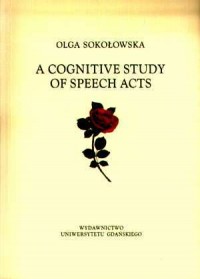
| Dane szczegółowe: | |
| Wydawca: | Wydawnictwo Uniwersytetu Gdańskiego |
| Oprawa: | twarda |
| Ilość stron: | 172 s. |
| Wymiar: | 145x240 mm |
| EAN: | 9788373260283 |
| ISBN: | 83-7326-028-5 |
| Data: | 2006-04-11 |
Opis książki:
1. THE PHENOMENON OF SPEECH ACTS 9
1.1. The emergence of the idea ... 10
1.2. Locutionary and illocutionary force. 11
1.3. Performatives and constatives 12
1.4. Illocutionary force and perlocutionary ef Tects ... 13
1.5. The legitimate andparasitic uses of language ... 14
1.6. Austin`s classification of illocutionary acts 15
1.7. Further developments of the speech act theory. 16
1.8. Illocutionary force - an issue of pragmatics 17
1.9. Illocutionary force - a matter of semantics 19
1.10. Sperber and Wilson`s theory of relevance. 21
1.11. Searle`s conditions of speech act performance ... 25
1.12. Searle`s classification of illocutionary acts. 27
1.13. Indirect speech acts 30
1.14. The perspectives of speech act studies 32
2. COGNITm SM AND PRAGMATICS - A PREPARATION FORASPEECH ACTSTUDY 33
2.1. General assumptions of cognitive linguistics 33
2.2. The cognitive idea of linguistic meaning .. 34
2.3. The cognitive approach to syntax ... 38
2.4. Pragmatics in cognitivism 40
2.5. The perspectives of cognitivism in the study of speech acts ... 42
2.6. Against the generative idea of illocutionary force 43
2.7. Illocutionary force - a cognitively oriented approach. .45
2.8. Traditional approaches to the pragmatic aspect of meaning ... 49
2.9. The schematicity of language - a pragmatic dimension 51
2.10. Conclusions .54
3. GENERATIYE SEMANTICS1 IDEA OF PERFORMATIYE SUPER-SENTENCES AND THEIRIMPACT ON THE SURFACE STRUCTURE OF UTTERANCES - A CRITICAL PRESENTATION 55
3.1. The issue of "lone" reflexive pronouns 55
3.2. Expositive adverbials ... 57
3.3. Adverbials in orders ... 59
3.4 The problem of indirect speech acts. 61
3.5. The issue of manifold illocutionary force .. 64
3.6. Conclusions 66
4. SPEECH ACTS AS NATURAL CATEGORIES. 67
4.1. The notion of a natural category ... 67
4.2. Felicity conditions 67
4.3. Prototype effects in speech acts 71
4.4. The directness of illocutionary force 73
4.5. The prototypes of speech acts and their status. 75
4.6. Speech act Gestalts 77
4.7. Speech acts as things ... 80
4.8. Non-prototypical performances of speech acts .. 82
4.9. The class of Representatives. 83
4.10. The class of Expressives 90
4.11. The class of Commissives 97
4.12. The class of Directives. 100
4.13. The classes of Declaratives and Representativ Declarations ... 104
4.14. The issue of image schemata of speech acts ... 106
4.15. Conclusions 108
5. LINGUISTIC IMAGERYIN SPEECH ACTS -THEORETICAL ASSUMPTIONS AND A PRACTICAL STUDY 110
5.1. The idea of imagery ... 111
5.2. The composite structure of speech acts .. 113
5.3. Imagery as the source of variety in speech act performance .. 114
5.4. Determining the form and lexical content of an utterance. . 116
5.5. The importance of prototypes 117
5.6. A practical application. 120
5.7. A cognitively oriented study of a speech act - invitations 121
5.8. Iiwitations - the model 121
5.9. Irwitations - departures from the model. 127
5.10. Invitations - the dimension of prototypicality. 131
5.11. Iiwitations and image schemata ... 136
5.12. Invitations - the dimension of directness 140
SUMMARY. 160
REFERENCES ... 165
Książka "A cognitive study of speech acts" - Olga Sokołowska - oprawa twarda - Wydawnictwo Uniwersytetu Gdańskiego.

